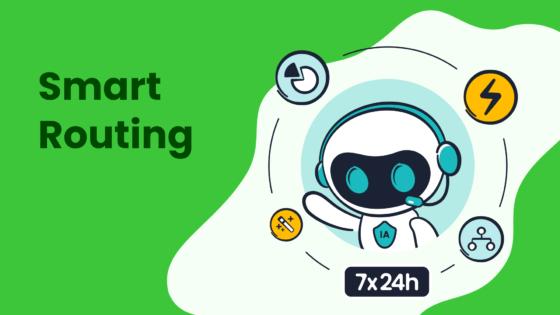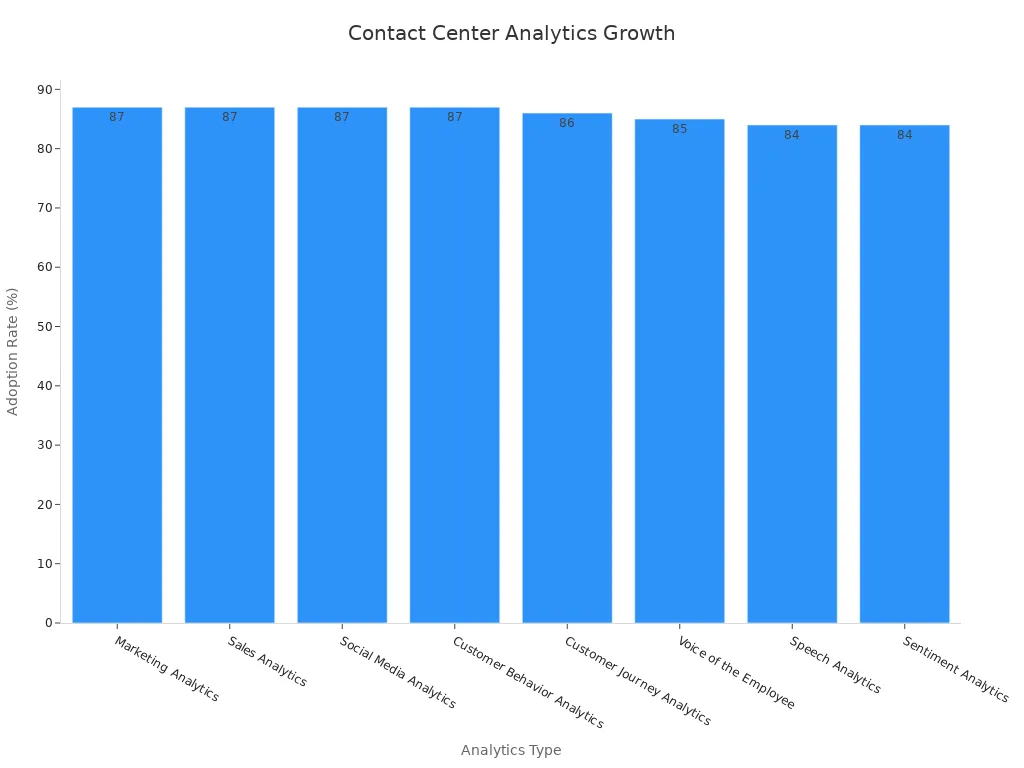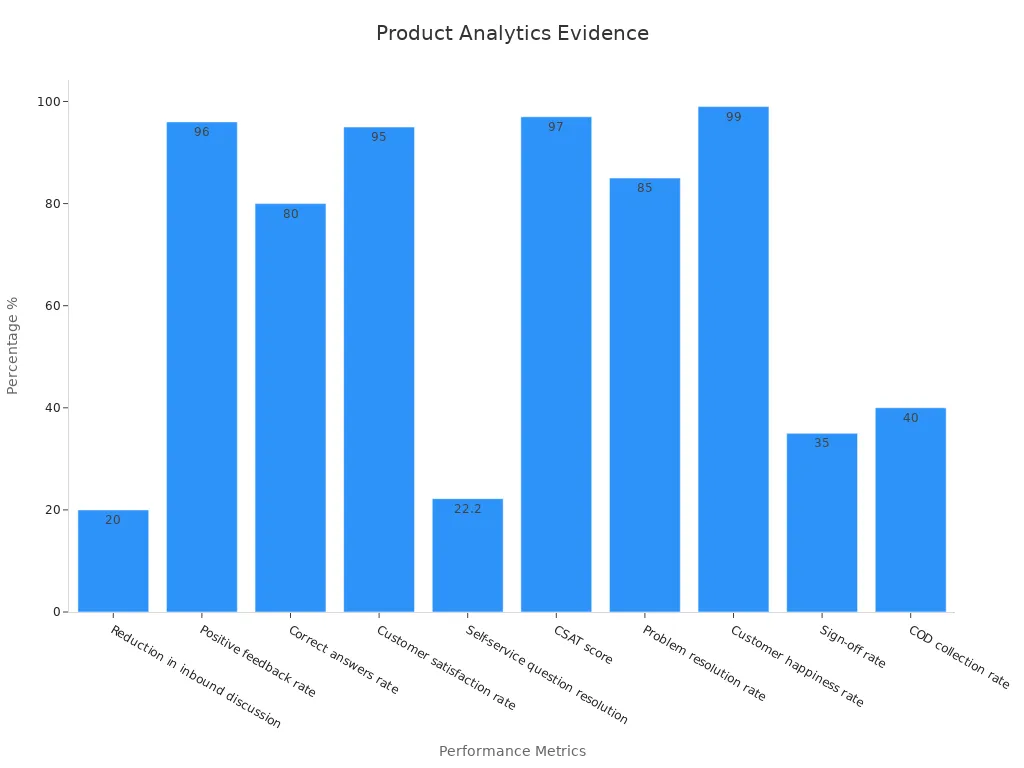Understanding Contact Center Interaction Analytics in 2025

Contact centre interaction analytics involves analyzing customer interactions across channels like voice, text, and social media. This process helps you improve customer service and optimize operations. In 2025, its importance has skyrocketed. Advancements in AI and machine learning have made analytics smarter and faster. Personalized customer experiences are now the norm, not the exception.
Here’s why this matters to you: automating routine interactions can reduce costs by 40-70%. Omnichannel strategies boost customer satisfaction by up to 30%. Self-service channels ensure 24/7 availability, meeting your customers’ needs anytime. Tools like Sobot empower you to stay ahead in this evolving landscape, providing comprehensive solutions for effective contact centre interaction analytics.
What is Contact Center Interaction Analytics?
Definition and Core Components
Contact center interaction analytics refers to the process of collecting and analyzing customer interactions across multiple communication channels. These channels include voice calls, emails, chat messages, and even social media posts. By leveraging advanced technologies like speech analytics, natural language processing (NLP), and machine learning, interaction analytics transforms unstructured data into actionable insights.
Key components of interaction analytics include:
- Customer Effort Analysis: Measures how easy it is for customers to resolve their issues.
- Emotional Analysis: Identifies customer emotions during interactions to gauge satisfaction.
- Intent Recognition: Understands the purpose behind customer inquiries to provide accurate solutions.
- Metadata Analysis: Examines contextual details like call duration, silence periods, and response times.

These components work together to help you understand customer behavior, improve service quality, and optimize agent performance. For example, Sobot’s Voice/Call Center uses AI-powered voicebots and intelligent IVR systems to analyze customer intent and streamline call routing, ensuring faster resolutions.
Types of Interactions Analyzed (Voice, Text, Social Media, etc.)
Interaction analytics covers a wide range of communication channels, making it a versatile tool for modern contact centers. Here’s a breakdown of the types of interactions analyzed:
- Voice Calls: Speech analytics tools extract insights from spoken words, tone, and pauses. For instance, Sobot’s call tracking feature captures call data to improve agent performance.
- Text-Based Channels: Chat messages, emails, and SMS are analyzed using NLP to identify sentiment and intent.
- Social Media: Platforms like Twitter and Facebook provide valuable customer feedback. Interaction analytics monitors these channels to track brand sentiment and respond to customer concerns.
- Video and Visual Interactions: Video calls and shared images are increasingly analyzed to enhance customer support in industries like retail and healthcare.
By analyzing these diverse channels, you can create a unified view of customer interactions. This omnichannel approach, as seen in Sobot’s solutions, ensures consistent and personalized experiences across all touchpoints.
Why It Matters for Modern Contact Centers
In today’s competitive landscape, understanding customer interactions is no longer optional—it’s essential. Interaction analytics empowers you to deliver exceptional service while optimizing operational efficiency.
Here’s why it matters:
- Improved Decision-Making: Advanced analytics tools provide data-driven insights, enabling you to make informed decisions. For example, conversational AI transforms customer interactions by identifying trends and predicting future needs.
- Enhanced Customer Satisfaction: Studies show that 49% of organizations report improved customer satisfaction through speech analytics. By understanding customer emotions and preferences, you can tailor your services to meet their expectations.
- Increased Agent Productivity: Embedding analytics into workflows boosts agent efficiency. Sobot’s unified workspace consolidates customer data, reducing the time agents spend switching between systems.
- Revenue Growth: Phone calls convert to revenue 10-15 times more than web leads, according to BIA/Kelsey. Interaction analytics helps you capitalize on these opportunities by optimizing call handling and follow-ups.
The contact center analytics market is projected to grow from $1.7 billion in 2022 to $2.9 billion by 2027, reflecting its rising importance. Adopting tools like Sobot’s Voice/Call Center can position your business to thrive in this evolving landscape.
How Does Contact Center Interaction Analytics Work?
Data Collection Across Channels
Interaction analytics begins with gathering data from various communication channels. These include voice calls, emails, chat messages, social media platforms, and even video interactions. Each channel provides unique insights into customer behavior and preferences. For example, speech analytics tools analyze call recordings to identify keywords and patterns in conversations. Similarly, text-based channels like chat and email rely on natural language processing to extract sentiment and intent.
To understand the effectiveness of data collection, consider the following metrics:
| Metric | Description |
|---|---|
| Reach | Number of people exposed to channels (impressions, views, followers, etc.) |
| Traffic | Number of visitors to channels (sessions, users, pageviews, etc.) |
| Engagement | Interactions with channels (likes, comments, shares, clicks, etc.) |
| Conversion | Actions taken on channels (leads, sign-ups, downloads, purchases, etc.) |
| Retention | Return visits to channels (repeat visits, loyalty, retention rate, churn rate, etc.) |
| Revenue | Money generated by channels (sales, revenue, profit, ROI, etc.) |
By collecting data across these channels, you can create a comprehensive view of customer interactions. This omnichannel approach ensures consistent and personalized service.
Analysis Using AI and Machine Learning
AI and machine learning play a critical role in analyzing the collected data. These technologies process vast amounts of information quickly and accurately. For instance, AI-powered call routing directs calls to the most suitable agents based on their skills. Predictive analytics identifies call patterns, helping you adjust staffing levels to meet demand. Sentiment analysis deciphers customer emotions, enabling agents to respond more effectively.
Here’s how AI enhances call center analytics:
| Evidence Type | Description |
|---|---|
| AI in Call Routing | Advanced algorithms improve call routing by directing calls to the right agents based on skills. |
| Predictive Analytics | AI-driven analytics provided insights into call patterns, allowing businesses to adjust staffing. |
| Sentiment Analysis | Understanding customer emotions through sentiment analysis enhances agent responses and satisfaction. |
| Performance Metrics | Companies using AI reduced call handling times by 30%, improving overall efficiency. |
These capabilities provide real-time insights, enabling you to make informed decisions and improve operational efficiency.
Generating Actionable Insights for Businesses
The ultimate goal of interaction analytics is to generate actionable insights that drive business success. These insights help you identify trends, predict customer needs, and optimize processes. For example, speech analytics can reveal common customer complaints, allowing you to address issues proactively. Real-time insights also enable immediate action, such as adjusting call queues during peak hours.
Consider how actionable insights have transformed industries:
| Industry | Company | Actionable Insight | Measurable Outcome |
|---|---|---|---|
| Logistics and Transport | UPS | Optimized delivery routes using ORION | Saved over 10 million gallons of fuel annually, $400 million in cost savings, improved customer satisfaction |
| Streaming Entertainment | Netflix | Personalized content recommendations | Increased user engagement, reduced churn, significant revenue growth |
By leveraging these insights, you can enhance customer satisfaction, reduce costs, and boost revenue. Tools like Sobot’s Voice/Call Center empower you to harness the full potential of interaction analytics, ensuring your business stays competitive.
Key Benefits of Contact Center Interaction Analytics in 2025

Enhancing Customer Experience Through Personalization
Personalization has become a cornerstone of modern customer support. Contact center interaction analytics enables you to tailor every interaction to meet customer preferences. By analyzing data from voice calls, chat messages, and social media, you can understand what your customers need and deliver solutions that resonate with them.
For example, 83% of customers feel more loyal to brands that respond to their feedback, and 68% are willing to pay more for brands known for excellent customer experiences. Companies like Amazon and Sephora have demonstrated how personalized customer experiences can drive loyalty and retention. In fact, 88% of consumers are more likely to become repeat customers after a positive service experience. This highlights the importance of using interaction analytics to improve contact center performance and foster long-term relationships.

Sobot’s Voice/Call Center exemplifies this by leveraging AI-powered voicebots and intelligent IVR systems to recognize customer intent and provide tailored solutions. These tools not only enhance customer satisfaction but also ensure that every interaction feels meaningful and relevant.
Improving Operational Efficiency and Reducing Costs
Call center analytics plays a pivotal role in streamlining operations and cutting costs. By analyzing call volumes, peak times, and agent performance, you can optimize staffing and resource allocation. This ensures that your team is neither overburdened nor underutilized.
Effective analytics allows you to balance call demand with workforce availability. For instance, analyzing peak call times helps you schedule agents more effectively, reducing idle time and improving response rates. Real-time monitoring also enables quick adjustments to staffing levels, ensuring optimal service delivery. These strategies can significantly reduce operational costs while maintaining high service quality.
Sobot’s solutions, such as its unified workspace and real-time monitoring tools, empower businesses to achieve these efficiencies. By consolidating customer data and providing actionable insights, Sobot helps you align your resources with customer needs. This not only reduces costs but also enhances overall productivity.
Enabling Predictive Decision-Making and Proactive Support
Predictive analytics transforms how you approach customer support. By analyzing historical data, you can anticipate customer needs and address issues before they arise. This proactive approach not only improves customer satisfaction but also positions your business as a leader in customer care.
Predictive decision-making enhances accuracy and confidence. Advanced algorithms identify trends and patterns, enabling you to forecast call volumes, customer behaviors, and potential risks. For example, businesses that use predictive analytics can develop strategies to mitigate risks and seize growth opportunities. This ensures that your contact center remains agile and responsive.

Sobot’s interaction analytics tools excel in this area. Features like AI-powered call routing and sentiment analysis allow you to predict customer needs and deliver proactive support. By integrating these tools into your operations, you can stay ahead of customer expectations and drive better outcomes.

The adoption rates of various analytics types, such as customer behavior analytics (87%) and sentiment analytics (84%), underscore the growing importance of predictive capabilities. These tools not only enhance decision-making but also ensure that your contact center remains competitive in 2025 and beyond.
Metrics and Tools for Contact Center Analytics
Key Metrics: CSAT, AHT, Sentiment Analysis, and FCR
Understanding key metrics is essential for improving call center analytics. These metrics provide insights into customer satisfaction, operational efficiency, and agent performance.
| Metric | Pros | Cons |
|---|---|---|
| AHT (Average Handle Time) | - Highlights efficiency and areas for improvement. - Helps with workforce planning. - Identifies training needs. | - Overemphasis can harm service quality. - Benchmarks vary by industry. |
| FCR (First Call Resolution) | - Strongly linked to customer satisfaction. - Reduces repeat contacts and costs. | - Hard to measure accurately. - May discourage agents from escalating complex issues. |
| CSAT (Customer Satisfaction Score) | - Simple to implement. - Pinpoints areas for improvement. | - Response bias from extreme opinions. - Scores influenced by customer mood. |
For example, T-Mobile improved FCR by 15% by enhancing agent knowledge bases, while Apple consistently achieves CSAT scores above 95% by empowering its support agents. These metrics, when tracked effectively, can transform your contact center analytics strategy.

Tools for Analytics: Sobot Voice/Call Center and Other Platforms
The right tools make interaction analytics more effective. Sobot’s Voice/Call Center stands out with features like AI-powered voicebots, intelligent IVR, and real-time monitoring. These tools help you analyze customer interactions across channels, reduce inbound discussions by 20%, and achieve a 95% customer satisfaction rate.
| Metric | Result |
|---|---|
| Reduction in inbound discussion | 20% |
| Positive feedback rate | 96% + |
| CSAT score | 97% |
| Problem resolution rate | 85% |

Other platforms also offer analytics capabilities, but Sobot’s unified workspace and seamless integration with CRM systems provide a comprehensive solution for businesses of all sizes.
Integrating Analytics with CRM and Workforce Management Systems

Integrating analytics with CRM and workforce management systems ensures a seamless flow of information. This integration allows you to access customer data, track interactions, and optimize agent schedules in one place. For example, Sobot’s Voice/Call Center integrates effortlessly with CRMs like Salesforce, enabling agents to view customer histories and resolve issues faster.
By combining analytics with workforce management, you can predict call volumes, adjust staffing levels, and improve service quality. This approach not only enhances operational efficiency but also ensures that your team delivers consistent and personalized experiences.
Future Trends and Innovations in Contact Center Interaction Analytics

The Role of Generative AI in Customer Interactions
Generative AI is revolutionizing how you engage with customers. By creating personalized experiences, it enhances satisfaction and loyalty. Companies like Spotify, Netflix, and Amazon already use generative AI to tailor recommendations. Spotify’s "Discover Weekly" playlists, for instance, keep users engaged by curating songs based on listening habits. Similarly, Netflix suggests shows aligned with your viewing history, while Amazon recommends products that match your preferences.
In call center analytics, generative AI can craft dynamic responses during customer interactions. It enables agents to provide accurate solutions faster by analyzing customer intent in real time. This technology also powers AI-driven chatbots, which handle repetitive queries, freeing agents to focus on complex issues. As a result, you can deliver seamless and efficient customer service.
Real-Time Analytics for Immediate Action
Real-time analytics empowers you to act quickly and decisively. It provides instant insights into call center operations, helping you address issues as they arise. For example, real-time metrics improve decision-making speed, allowing you to adjust staffing levels during peak hours. Predictive metrics also help you anticipate challenges, ensuring proactive management.
Consider these benefits:
- Real-time analytics enhances performance tracking, enabling you to identify coaching opportunities.
- Predictive tools forecast future trends, helping you prepare for potential disruptions.
- Immediate data access improves agility, ensuring your team delivers consistent service.
| Evidence Description | Impact on Operations |
|---|---|
| Real-time metrics provide immediate insights into call center operations. | Helps managers and agents make quick decisions and adjustments to prevent escalations and errors. |
| BI tools automate data gathering and analysis. | Ensures managers have up-to-date information for informed decision-making and tailored coaching programs. |
| Predictive metrics forecast future performance trends. | Allows proactive addressing of potential challenges in customer service. |
By leveraging real-time analytics, you can optimize call center analytics and maintain high service standards.
Ethical Considerations and Data Privacy in Analytics
As you adopt advanced analytics, ethical considerations and data privacy must remain a priority. Balancing customer trust with business goals requires careful planning. Frameworks like the FTC’s Fair Information Practices in the U.S. and GDPR in Europe set standards for data protection. However, the lack of global harmonization complicates compliance for multinational businesses.
AI-driven tools can help you manage these challenges. Automated compliance checks and real-time data protection measures safeguard sensitive information. These tools also adapt to regulatory changes, ensuring your operations remain secure. Ethical analytics practices not only protect customer data but also enhance your brand’s reputation.
To address these concerns, you should:
- Rethink security policies to align with evolving regulations.
- Build training programs that emphasize ethical data handling.
- Prioritize transparency in how you collect and use customer data.
By embedding ethical considerations into your call center analytics strategy, you can foster trust and loyalty among your customers.
Contact center interaction analytics has become essential for delivering exceptional customer experiences, streamlining operations, and making data-driven decisions. By analyzing interactions across channels, you can uncover insights that drive customer satisfaction and operational success.
📊 Pro Tip: Adopting advanced tools like Sobot's Voice/Call Center ensures you stay ahead in 2025. Its AI-powered features help you personalize interactions, optimize resources, and predict customer needs effectively.
Investing in these solutions positions your business for long-term growth and customer loyalty. Don’t wait—embrace the future of analytics today!
FAQ
What is the difference between interaction analytics and traditional call center metrics?
Traditional metrics like Average Handle Time (AHT) focus on efficiency. Interaction analytics goes deeper. It analyzes customer emotions, intent, and behavior across channels. This approach helps you understand customer needs better and improve service quality.
How does Sobot ensure data privacy in interaction analytics?
Sobot prioritizes data security. It uses encrypted data transfer and complies with global regulations like GDPR. Automated compliance checks and real-time protection measures safeguard sensitive customer information. These features ensure your data remains secure and trustworthy.
Can small businesses benefit from contact center interaction analytics?
Yes, small businesses can benefit greatly. Tools like Sobot’s Voice/Call Center offer affordable, scalable solutions. These tools help you analyze customer interactions, improve satisfaction, and optimize resources. Even with limited budgets, you can enhance customer experiences effectively.
How does AI improve contact center analytics?
AI processes large data sets quickly. It identifies patterns, predicts customer needs, and automates repetitive tasks. For example, Sobot’s AI-powered voicebots streamline call routing and reduce wait times. These capabilities improve efficiency and customer satisfaction.
Why is omnichannel analytics important for customer service?
Omnichannel analytics provides a unified view of customer interactions. It ensures consistent service across platforms like voice, chat, and social media. This approach helps you deliver personalized experiences, build loyalty, and meet customer expectations seamlessly.
💡 Pro Tip: Use Sobot’s Omnichannel Solution to unify your communication channels and provide consistent, high-quality service.
See Also
Best Call Center Analytics Tools To Use In 2024
Leading Contact Center Solutions Evaluated For 2024
Best Cloud-Enabled Contact Center Solutions Available In 2024
Best Speech Analytics Software For Call Centers In 2024
Ten Essential Steps For Implementing Omnichannel Contact Centers
